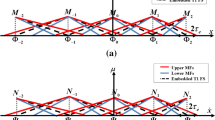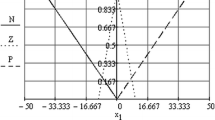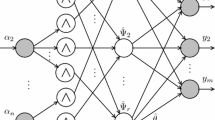Abstract
The main purpose of this study is to predict limit cycles of a dynamic fuzzy control system by combining a stability equation, describing function and parameter plane. The stability of a linearized dynamic fuzzy control system is then analyzed using stability equations and the parameter plane method, with the assistance of a describing function method. This procedure identifies the amplitude and frequency of limit cycles that are clearly formed by the dynamic fuzzy controller in the parameter plane. Moreover, the suppression of the limit cycle by adjusting control parameters is proposed. Continuous and sampled-data systems are addressed, and the proposed approach can easily be extended to a fuzzy control system with multiple nonlinearities. Simulations are performed to demonstrate the effectiveness of the proposed scheme.















Similar content being viewed by others
References
Abdelnour G, Cheung TY, Chang CH, Tinetti G (1993) Steady-state analysis of a three-term fuzzy controller. IEEE Trans Syst Man Cybern 23:607–610
Ackermann J, Bunte T (1997) Actuator rate limits in robust car steering control. In: Proceedings of the IEEE conference on decision and control, pp 4726–4731
Chang CH, Chang MK (1994) Analysis of gain margins and phase margins of a nonlinear reactor control system. IEEE Trans Nucl Sci 41:1686–1691
Chang W, Park JB, Joo YH, Chen G (2003) Static output-feedback fuzzy controller for Chen’s chaotic system with uncertainties. Inf Sci 151:227–244
Chen YL, Han KW (1970) Stability analysis of a nonlinear reactor control system. IEEE Trans Nucl Sci NS-17:18–25
Cheng CC, Huang CH (1998) On the limit cycle of the underwater vehicle control system. In: Proceedings of the international symposium on underwater technology, pp 461–465
Chu YC, Dowling AP, Glover K (1998) Robust control of combustion oscillations. In: Proceedings of IEEE international conference on control applications, pp 1165–1169
Cox CS, French IG (1986) Limit cycle prediction conditions for hydraulic control system. ASME J Dyn Syst Meas Control 108:17–23
D’Amico MB, Moiola JL, Paolini EE (2002) Hopf bifurcation for maps: a frequency-domain approach. IEEE Trans Circuits Syst I 49:281–288
Genesio R, Tesi A (1988) On limit cycles in feedback polynomial systems. IEEE Trans Circuits Syst 35:1523–1528
Genesio R, Tesi A, Villoresi F (1993) A frequency approach for analyzing and controlling chaos in nonlinear circuits. IEEE Trans Circuits Syst II 40:819–828
Gordillo F, Aracil J, Alamo T (1993) Determining limit cycles in fuzzy control systems. In: Proceedings of IEEE international conference on fuzzy systems, pp 193–198
Han KW (1977) Nonlinear control systems—some practical methods. Academic Cultural Company, California
Han KW (1979) Digital and sampled-data control systems. Kuang-Mei Publishing Co., Lungtan
Han KW, Thaler GJ (1966) Control system analysis and design using a parameter space method. IEEE Trans Autom Control 11:560–563
Hauksdottir AS, Sigurdaraottir G (1993) On the use of robust design methods in vehicle longitudinal controller design. ASME J Dyn Syst Meas Control 115:166–172
Itovich GR, Moiola JL (2006) On period doubling bifurcations of cycles and the harmonic balance method. Chaos Solitons Fractals 27:647–665
Kim E, Lee H, Park M (2000) Limit-cycle prediction of a fuzzy control system based on describing function method. IEEE Trans Fuzzy Syst 8:11–21
Li J, Wang HO, Niemann D, Tanaka K (2000) Dynamic parallel distributed compensation for Takagi–Sugeno fuzzy systems: an LMI approach. Inf Sci 123:201–221
Marco MD, Forti M, Tesi A (2002) Existence and characterization of limit cycles in nearly symmetric neural networks. IEEE Trans Circuits Syst I 49:979–992
Nagi F, Ahmed SK, Zainul Abidin AA, Nordin FH (2010) Fuzzy bang–bang relay controller for satellite attitude control system. Fuzzy Sets Syst 161:2104–2125
Nguang SK (2006) Robust H-infinity output feedback control design for fuzzy dynamic systems with quadratic D stability constraints: an LMI approach. Inf Sci 176:2161–2191
Olsson H, Astrom KJ (2001) Friction generated limit cycles, IEEE Trans. Control Syst Technol 9:629–636
Padin MS, Robbio FI, Moiola JL, Chen G (2005) On limit cycle approximations in the van der Pol oscillator. Chaos Solitons Fractals 23:207–220
Perng JW (2012) Describing function analysis of uncertain fuzzy vehicle control systems. Neural Comput Appl 21:555–563
Precup RE, David RC, Petriu EM, Preitl S, Paul AS (2011) Gravitational search algorithm based tuning of fuzzy control systems with a reduced parametric sensitivity. Soft Computing in Industrial Applications, Springer, Berlin, pp 141–150
Sadeghi-Tehran P, Cara AB, Angelov P, Pomares H, Rojas I, Prieto A (2012) Self-evolving parameter-free rule-based controller. In: Proceedings of IEEE conference on fuzzy systems, pp 754–761
Shenton AT (1999) Parameter space design of PID limit cycle controllers. In: Proceedings of American control conference, pp 3342–3346
Siljak DD (1964) Analysis and synthesis of feedback control systems in the parameter plane. IEEE Trans Ind Appl 83:466–473
Siljak DD (1969) Nonlinear systems—the parameter analysis and design. Wiley, New York
Siljak DD (1989) Parameter space methods for robust control design: a guide tour. IEEE Trans Autom Control 34:674–688
Tanaka K, Manabu S (1993) Fuzzy stability criterion of a class of nonlinear systems. Inf Sci 71:3–26
Tao CW, Taur JS, Chang CW, Chang YH (2012) Simplified type-2 fuzzy sliding controller for wing rock system. Fuzzy Sets Syst 207:111–129
Ting CS (2006) Stability analysis and design of Takagi–Sugeno fuzzy systems. Inf Sci 176:2817–2845
Xing J, Shi Z, Dai G (1996) Using describing function to analyze wriggling phenomenon of fuzzy control systems. In: Proceedings of IEEE conference on fuzzy systems, pp 1198–1204
Author information
Authors and Affiliations
Corresponding author
Additional information
Communicated by P. Angelov.
Rights and permissions
About this article
Cite this article
Perng, JW. Limit-cycle analysis of dynamic fuzzy control systems. Soft Comput 17, 1553–1561 (2013). https://doi.org/10.1007/s00500-012-0971-9
Published:
Issue Date:
DOI: https://doi.org/10.1007/s00500-012-0971-9




